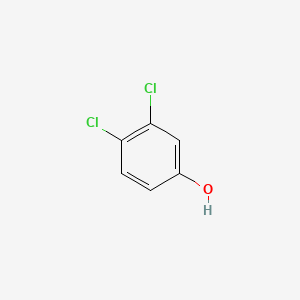D0696 | 3,4-dichlorophenol
| Toxicity | Dose | Time | Species | Model | Method | Action | Positive criterion | Reference |
|---|---|---|---|---|---|---|---|---|
| MEMBRANE POTENTIAL | 9.18±2.63 | human | qHTS-HepG2 | MMP assay | decrease | IC50 | 163 | |
| MEMBRANE POTENTIAL | 15.85 | human | HepG2 | MMP assay | decrease | IC50 | 163 | |
| MEMBRANE POTENTIAL | 53.88±13.03 | rat | hepatocytes | MMP assay | decrease | IC50 | 163 | |
| Pictogram | Signal | Statements | Precautionary Statement Codes |
|---|---|---|---|
  |
Danger |
Aggregated GHS information provided by 53 companies from 9 notifications to the ECHA C&L Inventory. Each notification may be associated with multiple companies. Reported as not meeting GHS hazard criteria by 1 of 53 companies. For more detailed information, please visit ECHA C&L website Of the 8 notification(s) provided by 52 of 53 companies with hazard statement code(s): H302 (90.38%): Harmful if swallowed [Warning Acute toxicity, oral] H315 (98.08%): Causes skin irritation [Warning Skin corrosion/irritation] H318 (75%): Causes serious eye damage [Danger Serious eye damage/eye irritation] H319 (23.08%): Causes serious eye irritation [Warning Serious eye damage/eye irritation] Information may vary between notifications depending on impurities, additives, and other factors. The percentage value in parenthesis indicates the notified classification ratio from companies that provide hazard codes. Only hazard codes with percentage values above 10% are shown. |
P264, P270, P280, P301+P312, P302+P352, P305+P351+P338, P310, P321, P330, P332+P313, P337+P313, P362, and P501; (The corresponding statement to each P-code can be found at the GHS Classification page.) |
  |
Warning |
H302: Harmful if swallowed [Warning Acute toxicity, oral] H371: May cause damage to organs [Warning Specific target organ toxicity, single exposure] |
P260, P264, P270, P301+P312, P309+P311, P330, P405, and P501; (The corresponding statement to each P-code can be found at the GHS Classification page.) |
| 002D258 | 070FTM6DVF | 3, 4-dichlorophenol |
| 3,3-dichloro-hydroxybenzene | 3,4 dichlorophenol | 3,4-DCP |
| 3,4-DICHLOROPHENOL | 3,4-Dichloro-phenol | 3,4-Dichlorophenol 10 microg/mL in Methanol |
| 3,4-Dichlorophenol 100 microg/mL in Methanol | 3,4-Dichlorophenol, 99% | 3,4-Dichlorophenol, PESTANAL(R), analytical standard |
| 3,4-Dichlorophenol, analytical standard | 3,4-dichloro phenol | 3,4-dichlorphenol |
| 3,4dichlorophenol | 4,5-Dichlorophenol | 4-06-00-00952 (Beilstein Handbook Reference) |
| 5JD; | 95-77-2 | AB1001897 |
| AC-16396 | ACMC-209s56 | ACT00759 |
| AKOS000119482 | ANW-40744 | AS00195 |
| BIDD:ER0233 | BRN 1907693 | C14462 |
| CAS-95-77-2 | CCRIS 5904 | CHEBI:34323 |
| CHEMBL1549385 | CTK3J0560 | D0395 |
| DB-021867 | DSSTox_CID_5005 | DSSTox_GSID_25005 |
| DSSTox_RID_77623 | DTXSID7025005 | EINECS 202-450-5 |
| F0001-2280 | FT-0614255 | HMS3039D07 |
| HSDB 4247 | InChI=1/C6H4Cl2O/c7-5-2-1-4(9)3-6(5)8/h1-3,9 | KM3375 |
| KS-00000UDB | KSC490K6B | LABOTEST-BB LT03379334 |
| LABOTEST-BB LTBB004367 | LS-1987 | MCULE-5939283710 |
| MFCD00002258 | MLS002454371 | NCGC00091625-01 |
| NCGC00091625-02 | NCGC00258229-01 | NSC 60648 |
| NSC-60648 | NSC60648 | OTAVA-BB 1506140 |
| PS-3014 | Phenol, 3,4-dichloro- | PubChem3698 |
| Q-200339 | Q27115989 | RTR-030068 |
| S993 | SBB058866 | SC-57898 |
| SCHEMBL224868 | SMR001371993 | ST2417235 |
| ST50824840 | STR01808 | TF10056 |
| TR-030068 | TRA0064218 | Tox21_200675 |
| UNII-070FTM6DVF | UNII-AZ1041M258 component WDNBURPWRNALGP-UHFFFAOYSA-N | WDNBURPWRNALGP-UHFFFAOYSA-N |
| Z1262254354 | ZINC388513 |

